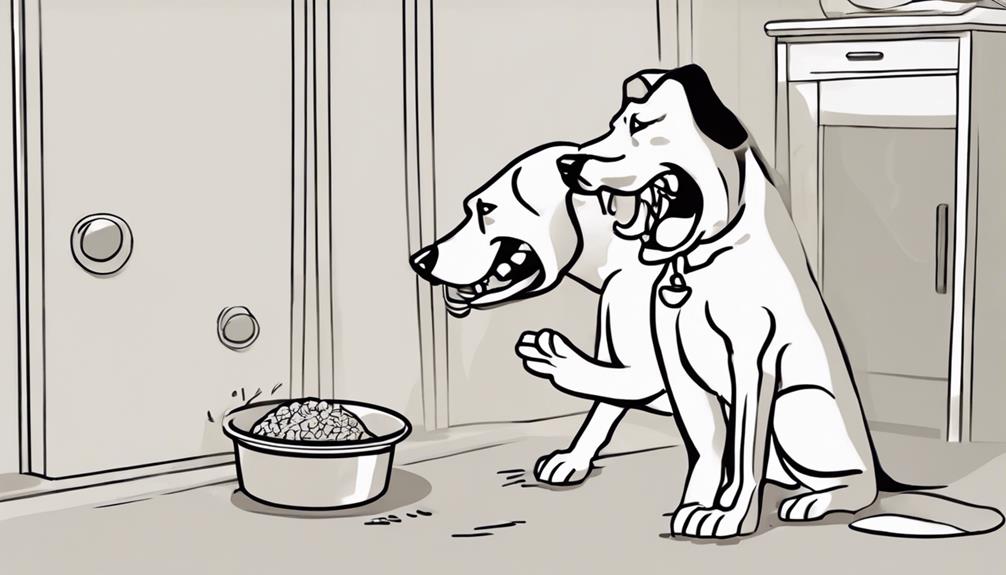Decoding Territorial Behavior in Canine Psychology
Imagine your dog, a loyal companion within the safe confines of your home, suddenly exhibiting signs of territorial behavior when a new neighbor's pet strolls by. The intricate world of canine psychology unveils layers of understanding behind this seemingly instinctual response.
As you observe your furry friend's reactions, you may start to wonder about the underlying motivations and triggers that dictate their territorial instincts. Unraveling the complexities of territorial behavior in dogs can provide valuable insights into their social interactions and emotional well-being, ultimately shaping how you navigate your canine companion's world.
The Role of Territory in Canine Behavior
Understanding the significance of territory is crucial in comprehending canine behavior. Dogs have a natural instinct to establish boundaries within their environment, leading to territorial behaviors such as boundary disputes and resource guarding. Boundary disputes can arise when a dog feels the need to protect its perceived territory from intruders, whether they're humans or other animals. This behavior often manifests through barking, growling, or even aggressive actions to defend the perceived boundary.
Resource guarding is another common territorial behavior where a dog protects valuable items such as food, toys, or sleeping areas. This behavior can be triggered by perceived threats to the dog's resources, leading to possessive and sometimes aggressive reactions. Understanding these territorial instincts is essential for dog owners to prevent conflicts and ensure a harmonious environment for their pets.
Proper training and positive reinforcement techniques can help address territorial behaviors and promote a peaceful coexistence between dogs and their human companions.
Factors Influencing Territorial Aggression
Territorial aggression in dogs can be influenced by various factors, including their breed predispositions and past experiences. Genetic influences play a significant role in how dogs exhibit territorial behavior. Certain breeds may have a higher tendency towards territorial aggression due to their genetic makeup. Environmental triggers also play a crucial part in escalating territorial tendencies. Stressful environments or past traumatic experiences can heighten a dog's territorial response.
Canine perception is another key factor. Dogs perceive their territory differently based on a variety of factors such as size, boundaries, and perceived threats. Understanding how your dog perceives their territory can help in managing and preventing aggressive behaviors.
Human intervention is essential in shaping a dog's territorial behavior. Proper training, socialization, and providing a secure environment can help mitigate territorial aggression in dogs.
Understanding Marking Behavior in Dogs
Exploring the instinctual behavior of marking in dogs provides insights into their communication and territorial assertion. Scent communication is a vital component of a dog's marking behavior. When a dog marks a specific area with their scent, they're leaving behind a message for other dogs, indicating their presence, status, and territory. This form of communication is essential for dogs to establish boundaries and convey information to other animals in their environment.
Hormonal influences also play a significant role in marking behavior. Male dogs, in particular, are known to mark their territory more frequently than females, mainly due to higher levels of testosterone. Hormones can trigger marking behavior in response to various stimuli, such as the presence of other animals or changes in their surroundings.
Understanding these aspects of marking behavior in dogs can help pet owners interpret their pets' actions and provide appropriate training and guidance. By recognizing the importance of scent communication and hormonal influences, you can better support your dog's natural instincts while maintaining a harmonious relationship within your shared territory.
Social Dynamics Within Canine Territories
When observing dogs interacting within their territories, you'll notice a complex web of social dynamics at play.
Key Social Dynamics in Canine Territories:
- Dominance Hierarchy and Pack Mentality: Dogs establish a hierarchy within their pack, with some displaying dominant behaviors while others assume submissive roles. This hierarchy helps maintain order and reduces conflict within the group.
- Resource Guarding: Dogs may exhibit resource guarding behaviors within their territories, protecting valuable items such as food, toys, or sleeping areas. This behavior stems from an instinctual need to secure resources for survival.
- Social Interactions: Canine territories serve as hubs for social interactions where dogs communicate through body language, vocalizations, and scent marking. These interactions help reinforce bonds within the pack and establish social norms.
Understanding these social dynamics is crucial for interpreting canine behaviors within their territories and can aid in creating harmonious environments for our furry companions.
Managing Territorial Conflicts in Multi-Dog Homes
To effectively manage conflicts in multi-dog homes, establish clear boundaries and reinforce positive behaviors through consistent training and supervision.
When introducing new dogs to your multi-dog household, do so gradually, allowing the dogs to get acquainted in a neutral space before bringing them into the home. This helps prevent territorial disputes and reduces the likelihood of conflicts arising.
Additionally, managing resource guarding is crucial in preventing confrontations among your furry companions. Ensure that each dog has their own food and water bowls, toys, and resting areas to minimize the need for competition over resources.
If resource guarding behaviors do occur, seek professional guidance to address the issue promptly and effectively. By proactively managing introductions and resource guarding, you can create a harmonious environment where your dogs feel secure and content, reducing the potential for territorial conflicts in your multi-dog home.
Canine Body Language in Territorial Situations
In homes with multiple dogs, being able to recognize and interpret canine body language in territorial situations is key to preempting conflicts and fostering peaceful interactions among your furry companions. Understanding their communication cues and body language can help you intervene before situations escalate into full-blown boundary disputes.
Here are three essential points to keep in mind:
- Posture and Gestures: Pay attention to your dogs' body posture, such as stiffening, raised hackles, or direct staring, as these can indicate tension or aggression in a territorial context.
- Vocalizations: Different vocalizations, like growling, barking, or whining, can also convey your dogs' feelings about their territory or interactions with other dogs.
- Facial Expressions: Dogs' facial expressions, including bared teeth or a wrinkled muzzle, can provide valuable insights into their emotional state during territorial encounters.
Training Techniques for Territorial Dogs

Observing your dog's behavior patterns can provide valuable insights into effective training techniques for territorial dogs. When dealing with a territorial pup, positive reinforcement is key. Reward good behavior like calm interactions with strangers or other animals to reinforce the desired response. This approach helps your dog associate positive outcomes with non-aggressive behavior, encouraging them to remain calm in territorial situations.
Another crucial aspect of training territorial dogs is boundary setting. Establish clear boundaries within your home or yard to define your dog's territory. Use physical markers like fences or verbal cues to signal where their territory begins and ends. Consistency is vital in reinforcing these boundaries, helping your dog understand and respect their space.
Recognizing Signs of Stress in Territorial Behavior
How can you identify signs of stress in territorial behavior displayed by dogs?
When observing your furry friend's territorial behavior, it's crucial to recognize any signals of distress they might be showing. Here are three key indicators to watch out for:
- Increased Aggression: If your dog becomes more aggressive towards perceived threats to their territory, such as growling, barking, or lunging, it could be a sign of stress.
- Excessive Vocalization: Excessive barking or whining beyond the usual territorial alerts might indicate that your dog is feeling overwhelmed or anxious about the territory.
- Body Language Changes: Pay attention to any changes in your dog's body language, such as tense muscles, raised fur, or a tucked tail. These could be signs that they're stressed about their territorial boundaries.
To help your dog cope with territorial stress, it's essential to identify triggers that lead to their anxiety and implement behavior modification techniques. By addressing these triggers and using positive reinforcement methods, you can help your furry friend feel more secure in their territory.
Frequently Asked Questions
Can Dogs With Territorial Behavior Ever Fully Overcome Their Tendencies, or Will They Always Exhibit Some Level of Territorial Aggression?
You can help dogs with territorial behavior through behavioral therapy and training techniques. By addressing canine anxiety and stress management, you can make progress in reducing their territorial aggression.
While some dogs may always have a tendency towards territorial behavior, with consistent training and positive reinforcement, they can learn to control and minimize these tendencies over time.
Is There a Genetic Component to Territorial Behavior in Dogs, or Is It Purely Learned Through Socialization and Experiences?
Genetic influences play a significant role in your dog's territorial behavior. While socialization and experiences can shape their actions, their genetic makeup also contributes to how territorial they may be.
Through behavioral training, you can help manage and modify these instincts. Understanding the genetic component can guide you in developing effective strategies to address territorial behavior in your canine companion.
How Do Different Breeds of Dogs Vary in Their Propensity for Territorial Behavior, and Are There Certain Breeds That Are More Prone to Territorial Aggression?
Different breeds of dogs vary in their propensity for territorial behavior. Some breeds are more prone to territorial aggression due to their genetic makeup. It's essential to understand breed tendencies when addressing territorial issues.
Training techniques play a crucial role in managing triggers and modifying behavior. By considering both nature and nurture, you can effectively address territorial behavior in dogs and create a harmonious living environment for both you and your pet.
Are There Any Specific Environmental Triggers That Can Escalate a Dog's Territorial Behavior, and How Can Owners Effectively Manage or Eliminate These Triggers?
Identifying triggers that escalate your dog's territorial behavior is crucial. By recognizing these triggers, you can work on behavior modification techniques to effectively manage or eliminate them.
Pay attention to situations or objects that provoke your dog's territorial instincts, such as strangers near their favorite spot. With consistent training and positive reinforcement, you can help your furry friend feel more secure and reduce their territorial tendencies.
Can Professional Behaviorists or Trainers Effectively Modify a Dog's Territorial Behavior, or Is It a Trait That Is Difficult to Change Once Established?
Professional behaviorists or trainers can effectively modify a dog's territorial behavior. Training techniques and behavioral modification strategies can be implemented to address this issue.
By identifying triggers and managing the environment, significant progress can be made in changing the dog's behavior.
It isn't a trait that's impossible to change once established; with the right approach and consistency, positive results can be achieved.
Conclusion
Now that you have a better understanding of territorial behavior in canine psychology, you can approach training and managing your dog's behavior with more confidence.
By recognizing the signs of territorial aggression and stress, you can prevent conflicts and create a harmonious environment for your furry friends.
Remember to use positive reinforcement and consistent training techniques to help your dog feel secure and confident in their territory.
With patience and understanding, you can build a strong bond with your canine companion.
